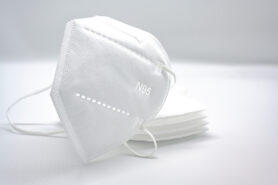The NNPHI Network At Work: Public Health Institutes Collaborate to Obtain Critical PPE Supplies
- Author
- By: Fahrenheit Creative Group
- Date
NNHPI’s COVID-19 Taskforce is bringing together member institutes from across the country to address some of the most pressing challenges exacerbated by COVID-19. From health equity to workforce development, these groups are making real change in their communities—and the country—through advocacy and policy, research, and community organizing. These are their stories of impact.
Earlier this year, several member institutes teamed up to tackle one of the most crucial challenges facing the nation—a massive shortage of personal protective equipment (PPE). The workgroup began meeting in May 2019 to discuss the critical need for quality, reliable, and low-cost PPE in health care settings, nursing homes, and their communities more broadly. The shortage of PPE, which included masks, gowns, and face shields, was, and in some areas continues to be, an incredibly dangerous issue as health care providers in a variety of settings are testing and treating patients infected with COVID-19.
NNPHI COVID-19 Taskforce
Hawai’i Public Health Institute
Illinois Public Health Institute
Public Health Institute
Public Health Institute of Metropolitan Chicago
Public Health Solutions
Puerto Rico Public Health Trust
By the first May meeting, member institutes across the county had already begun coordination efforts to gather and supply PPE to their communities:
In New York, the headquarters of Public Health Solutions (PHS) was transformed into a PPE storage facility where they coordinated distribution of supplies with other non-profit organizations. One of their key functions was to help sort PPE that was appropriate for hospitals or other direct care settings from other PPE that could be used by other organizations.
Similarly, the Puerto Rico Public Health Trust (PRPHT) was mapping COVID-19 infections on the island and distributing PPE to the areas that were most affected. They have also worked with a 3-D printing company to create and distribute face shields to the community.
The Hawai‘i Public Health Institute (HPHI) has observed issues with getting PPE to the island and, most concerningly, shortages among private practice doctors and dentists who were being pressured to reopen in the spring. Like other member institutes, the main function of HPHI was collecting and distributing PPE donations with the goal of coordinating the pull and push of supply and demand while prioritizing health and safety for the most at-risk community members.
In Chicago, the Illinois Public Health Institute (IPHI) provided in-kind staff support to the health department to organize PPE donations and distribution. Their staff worked with medical directors and racial rapid response teams to identify organizations that needed PPE and coordinated volunteer-led deliveries and logistics related to the distribution of PPE supplies.
The Public Health Institute of Metropolitan Chicago (PHIMC) was approached by two volunteer organizations that were raising money for PPE. PHIMC was able to manage the financial donations and connected those organizations to the health department and distribution sites to get more PPE to hospitals in neighborhoods that were most impacted.
As conversations among member institutes in this group continued throughout the spring and summer, it became clear that there were some major hurdles to securing high-quality and affordable PPE, including a spike in prices as PPE supplies dwindled throughout the country. Other barriers, such as order minimums and the reliability of PPE vendors, slowed the process to order enough PPE to meet the needs of their states.
 To address these challenges, the workgroup began researching, negotiating, and ultimately selecting a PPE provider that would accept a multi-organization contract. The group purchasing contract with W.B. Mason provided member institutes with competitive negotiated rates and access to PPE. W.B. Mason managed sourcing, supplier negotiations and logistics, and quality assurance for PPE, enabling the member institutes to focus on services and operations.
To address these challenges, the workgroup began researching, negotiating, and ultimately selecting a PPE provider that would accept a multi-organization contract. The group purchasing contract with W.B. Mason provided member institutes with competitive negotiated rates and access to PPE. W.B. Mason managed sourcing, supplier negotiations and logistics, and quality assurance for PPE, enabling the member institutes to focus on services and operations.
Facing similar challenges and with little inter-state coordination, NNPHI’s member institutes came together to address a pressing need in their communities. These stories from institutes illustrate how the member network can fill gaps in the public health infrastructure—from coordinating supplies and volunteers to conducting community needs assessments to acting as fiscal agent for donations—and demonstrate the value and essential-ness of the non-governmental public health workforce as partners in the pandemic response and recovery.

 Subscribe To Our Communications
Subscribe To Our Communications